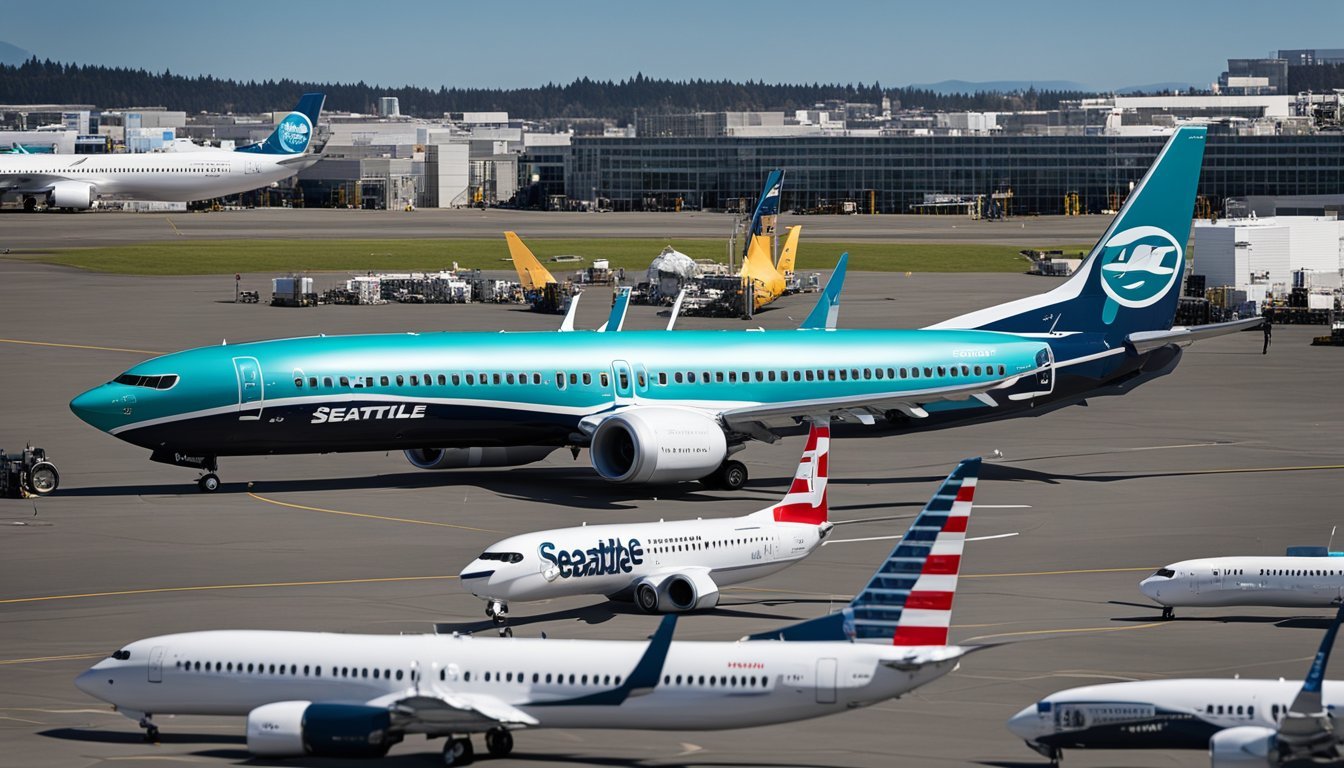The Seattle Times' Aviation Expertise Illuminates Industry Challenges Through Boeing 737 Max Reporting
The Seattle Times has emerged as a leading voice in reporting on the Boeing 737 MAX saga. Their coverage has shed light on critical safety and quality concerns surrounding the aircraft's production and certification process.
The newspaper's in-depth investigations have revealed how Boeing engineers were pressured to limit safety analysis and testing on planes, including the 737 MAX. This reporting has played a crucial role in informing the public and policymakers about potential shortcomings in aviation safety oversight.
The Seattle Times' expertise in aviation reporting has proven invaluable as the 737 MAX story continues to unfold. Their ongoing coverage of production caps, delivery issues, and Boeing's efforts to address safety concerns demonstrates the importance of specialized knowledge in newsrooms when tackling complex industry-specific stories.
The Importance of Aviation Expertise
Aviation expertise plays a crucial role in accurate and impactful reporting on complex aerospace issues. Specialized knowledge enables journalists to effectively investigate, analyze, and communicate technical information to the public.
Role of Specialized Journalists
Aviation journalists bring essential technical understanding to newsrooms. They can decipher complex aircraft systems, regulatory processes, and industry practices. This expertise allows them to ask probing questions and identify key issues that may elude general reporters.
Specialized journalists also develop valuable industry contacts. These relationships provide access to insider information and expert sources. Aviation reporters can quickly fact-check claims and put events into proper context.
Their in-depth knowledge helps newsrooms avoid common pitfalls in aviation coverage. They can distinguish between routine incidents and serious safety concerns. This prevents unnecessary alarmism while ensuring important stories receive proper attention.
Impact on Public Understanding
Aviation experts in journalism significantly enhance public comprehension of aerospace matters. They translate technical jargon into clear, accessible language for general audiences. This clarity is vital when reporting on complex topics like aircraft design or air traffic control systems.
These journalists provide critical analysis of industry trends and safety issues. They can explain the implications of new technologies or regulatory changes. This informed perspective helps readers grasp the broader impact of aviation developments on travel, commerce, and safety.
Expert reporting also serves as a watchdog function. It holds manufacturers, airlines, and regulators accountable. Informed journalists can spot inconsistencies in official statements and dig deeper into potential problems.
Overview of Boeing 737 Max Incidents
The Boeing 737 Max faced severe safety issues that led to two fatal crashes and a global grounding. These incidents sparked intense scrutiny of Boeing's practices and aviation safety regulations.
Timeline of Events
October 29, 2018: Lion Air Flight 610 crashes in Indonesia, killing all 189 people on board.
March 10, 2019: Ethiopian Airlines Flight 302 crashes, resulting in 157 fatalities.
March 13, 2019: FAA grounds all 737 Max aircraft in the United States.
March 2019 - November 2020: Global grounding of 737 Max fleet.
November 18, 2020: FAA lifts grounding order for 737 Max.
January 2021: Boeing agrees to pay $2.5 billion to settle criminal charges related to the crashes.
December 2022: FAA mandates additional safety upgrades for 737 Max aircraft.
The Max Crashes in Indonesia and Ethiopia
Both crashes involved the 737 Max's Maneuvering Characteristics Augmentation System (MCAS). This system was designed to prevent stalls but malfunctioned due to faulty sensor readings.
In the Lion Air crash, pilots struggled to control the aircraft as MCAS repeatedly pushed the nose down. The Ethiopian Airlines incident followed a similar pattern.
Investigations revealed design flaws, inadequate pilot training, and lapses in the certification process. These findings led to widespread criticism of Boeing and aviation regulators.
The crashes exposed shortcomings in Boeing's safety culture and highlighted the need for stricter oversight in aircraft certification processes.
Investigative Reporting by The Seattle Times
The Seattle Times' investigative reporting on the Boeing 737 MAX crisis showcased the newspaper's aviation expertise and commitment to in-depth journalism. Their coverage exposed critical safety issues and regulatory oversights, leading to significant industry changes.
Dominic Gates' Contributions
Dominic Gates, The Seattle Times' aerospace reporter, played a pivotal role in uncovering the Boeing 737 MAX scandal. His technical knowledge and industry connections allowed him to break key stories about the aircraft's flawed design and certification process. Gates' reporting revealed crucial details about the Maneuvering Characteristics Augmentation System (MCAS) and its role in the two fatal crashes.
His articles exposed Boeing's internal struggles and the Federal Aviation Administration's inadequate oversight. Gates' work prompted congressional hearings and led to major reforms in aviation safety regulations.
Awards and Recognition
The Seattle Times' Boeing 737 MAX coverage earned numerous prestigious journalism awards. The newspaper received the 2020 Pulitzer Prize for National Reporting for its groundbreaking investigation. The Pulitzer committee praised the team's "groundbreaking stories that exposed design flaws in the Boeing 737 MAX."
The reporting also garnered a George Polk Award for Business Reporting and a Scripps-Howard Award for Business and Financial Journalism. These accolades recognized the newspaper's impact on public safety and corporate accountability.
Collaborations and Key Journalists
The Seattle Times' investigative team collaborated effectively to produce comprehensive coverage of the Boeing 737 MAX crisis. Michele Matassa Flores, the executive editor, guided the overall strategy. Mike Baker, Steve Miletich, and Lewis Kamb contributed key investigative pieces.
Rami Grunbaum and Paul Roberts provided essential business analysis. Visual journalists Mike Siegel, Mark Nowlin, and Gabriel Campanario created impactful graphics and illustrations to explain complex technical concepts. This collaborative effort demonstrated the power of local journalism in tackling global issues and holding major corporations accountable.
Boeing's Safety and Design Concerns
Boeing faced significant scrutiny over safety and design issues related to its 737 MAX aircraft. Problems with flight control systems, regulatory oversight, internal reporting, and manufacturing processes raised serious concerns about the company's practices.
Flaws in the Flight Control System
The Maneuvering Characteristics Augmentation System (MCAS) emerged as a critical flaw in the 737 MAX design. This automated system was intended to prevent stalls but could activate erroneously based on faulty sensor data. In two fatal crashes, MCAS repeatedly pushed the nose of the plane down, overwhelming pilots. Boeing initially failed to disclose MCAS to airlines and pilots, leaving them unprepared to handle malfunctions.
Engineers later identified additional problems with MCAS, including its reliance on a single sensor and ability to activate multiple times. These issues highlighted gaps in Boeing's safety analysis and design processes.
Certification and Oversight Challenges
The FAA's certification of the 737 MAX came under intense criticism. Questions arose about the agency's practice of delegating significant oversight responsibilities to Boeing employees. This raised concerns about potential conflicts of interest and insufficient scrutiny of critical systems like MCAS.
Investigators found that the FAA lacked full awareness of MCAS changes made late in the development process. This pointed to breakdowns in communication and transparency between Boeing and regulators.
The certification process also failed to adequately assess how pilots would respond to multiple system failures. This exposed weaknesses in assumptions about human factors and emergency procedures.
The Role of Whistleblowers
Internal Boeing whistleblowers played a crucial role in exposing safety concerns. Some engineers raised alarms about design issues and pressure to cut costs at the expense of safety. Others reported problems with the 737 MAX's production process and quality control.
These whistleblowers faced challenges in getting their concerns addressed within Boeing. Some reported experiencing retaliation or pressure to stay quiet. Their experiences highlighted potential cultural issues within the company related to safety reporting and accountability.
Systemic Production and Quality Issues
Beyond specific design flaws, broader problems emerged in Boeing's manufacturing processes. Quality control lapses led to debris being left inside completed aircraft. Inspections uncovered improperly installed wiring and other defects.
Production pressures may have contributed to these issues. Workers reported feeling rushed to meet delivery targets. Some claimed that raising quality concerns could lead to negative consequences.
The FAA identified non-compliance with manufacturing standards during audits. This led to increased oversight and a temporary production cap on the 737 MAX. These measures aimed to ensure Boeing addressed systemic quality control problems.
Federal and Industry Response
The Boeing 737 MAX crisis prompted sweeping changes across the aviation industry. Regulators, manufacturers, and airlines implemented new safety measures and oversight processes to address systemic issues.
FAA Oversight and Reforms
The Federal Aviation Administration (FAA) faced criticism for its "cozy" relationship with Boeing. In response, the agency strengthened its oversight of aircraft certification and manufacturing processes. The FAA implemented a more rigorous Safety Management System (SMS) requirement for aviation companies, with a May 2027 deadline for compliance.
The agency conducted extensive audits of Boeing and its suppliers. These reviews uncovered multiple instances of non-compliance with quality control requirements. As a result, the FAA maintained production caps on the 737 MAX and continued to issue individual airworthiness certificates for each newly manufactured aircraft.
The FAA also developed a Comprehensive Action Plan to address systemic quality-control issues within Boeing's operations. This plan included enhanced supplier oversight and stricter manufacturing quality standards.
Boeing's Internal Changes
Boeing implemented significant internal reforms to address safety concerns and rebuild trust. The company overhauled its safety culture and established a new Compliance and Ethics Program. This program aimed to improve transparency and accountability throughout the organization.
Boeing introduced enhanced employee training programs focused on safety protocols and quality control. The company also established an anonymous reporting system for employees to flag potential safety issues without fear of reprisal.
To ensure ongoing improvement, Boeing implemented new performance metrics to track safety and quality indicators. The company also committed to regular independent outside assessments of its safety practices and manufacturing processes.
Global Aviation Safety Enhancements
The 737 MAX crisis sparked worldwide efforts to improve aviation safety. Regulatory bodies around the globe reassessed their certification processes and increased scrutiny of aircraft manufacturers.
International cooperation in aviation safety expanded, with agencies sharing information and best practices more readily. Many countries implemented stricter requirements for pilot training, particularly regarding automated flight control systems.
Airlines worldwide reviewed and updated their safety protocols, focusing on crew training and emergency response procedures. The industry also invested in new technologies to enhance aircraft monitoring and early detection of potential safety issues.
The Way Forward for Boeing and Aviation Industry
Boeing faces significant challenges as it seeks to regain its competitive position against Airbus and restore public trust. The company must focus on innovation, transparency, and safety to chart a successful path forward.
Innovation and Engineering Shifts
Boeing needs to accelerate its engineering efforts to catch up with Airbus in key market segments. The company should prioritize developing new single-aisle jets to compete with the popular Airbus A321neo. This may involve investing in advanced materials and more fuel-efficient engine technologies.
Boeing must also enhance its digital capabilities. Implementing a robust digital record-keeping platform could improve quality control and streamline production processes. This would help address past issues and boost efficiency.
Simulation and training technologies require upgrades to ensure pilots are well-prepared for all scenarios. Enhanced virtual reality systems could provide more realistic and comprehensive training experiences.
Transparency and Public Trust
Rebuilding trust is crucial for Boeing's long-term success. The company should commit to regular public updates on safety improvements and production progress. This includes being upfront about any setbacks or challenges encountered.
Boeing needs to engage more openly with airlines, regulators, and the public. Hosting forums for stakeholders to voice concerns and provide feedback could help rebuild relationships.
Transparency in the regulatory process is essential. Boeing should work closely with aviation authorities to ensure all certification requirements are met and clearly communicated.
Strengthening Air Safety Measures
Boeing must implement rigorous quality control measures across its production lines. This includes regular "quality stand downs" to assess and improve manufacturing processes.
Enhancing the role of safety engineers in decision-making processes is critical. Their input should be given greater weight in design and production choices.
Boeing should lead industry efforts to improve aviation safety standards. This could involve proposing new regulations or developing advanced safety technologies that go beyond current requirements.
Supporting airlines with comprehensive safety audits and ongoing technical assistance will help ensure the safe operation of Boeing aircraft worldwide.
Impact of the COVID-19 Pandemic on Aviation
The COVID-19 pandemic severely disrupted the aviation industry, causing unprecedented challenges for airlines, manufacturers, and related businesses. Passenger traffic plummeted, leading to massive financial losses and operational changes across the sector.
Adaptations in Reporting and Industry Practices
Airlines faced drastic reductions in demand, with passenger traffic dropping by 96% in April 2020 compared to the previous year. This forced carriers to park or retire many aircraft, impacting maintenance schedules and supply chains.
Boeing, a major aircraft manufacturer, reported nearly $12 billion in losses for 2020 due to weakened demand. The company's market outlook projected a 7% lower forecast over 10 years compared to pre-pandemic estimates.
Journalists covering aviation adapted their reporting focus. They shifted from primarily covering new aircraft developments to analyzing industry-wide financial struggles, government support measures, and public health protocols in air travel.
Communication strategies evolved as airlines and airports implemented new safety measures. They increased their digital presence to inform passengers about health requirements and booking flexibility.
Conclusion
The Seattle Times' coverage of the Boeing 737 MAX crisis demonstrates the value of specialized aviation expertise in newsrooms. Their in-depth reporting uncovered critical issues at Boeing's Renton Factory.
Whistleblowers played a key role in exposing problems with the 737 MAX planes. Their revelations shed light on manufacturing defects and safety concerns that may have contributed to two tragic crashes.
The newspaper's persistent investigation forced greater transparency from Boeing and regulators. This reporting likely contributed to enhanced scrutiny of the aircraft's design and production processes.
Local journalists with deep industry knowledge proved essential in unraveling the complex technical and regulatory issues surrounding the 737 MAX. Their work highlights the importance of maintaining subject matter expertise in newsrooms.
The Seattle Times' coverage serves as a model for how media outlets can effectively report on specialized industries and hold powerful corporations accountable.





